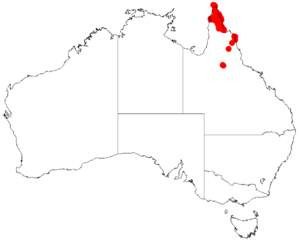Acacia brassii facts for kids
Quick facts for kids Acacia brassii |
|
|---|---|
| Scientific classification | |
| Genus: |
Acacia
|
| Species: |
brassii
|
 |
|
| Occurrence data from AVH | |
Acacia brassii is a type of shrub or small tree. It belongs to the large Acacia family. This plant grows naturally in the northeastern parts of Australia.
About the Plant
This tree usually grows up to 10 m (33 ft) (about 33 feet) tall. It has bark that is dark brown to grey. The bark also has long cracks running down it.
Branches and Leaves
The branches are dark red to brown. They are mostly smooth, meaning they have no hairs. Some might have a few light hairs. The ends of the branches are flat and have rough, flaky lines called scurfy ridges.
Like most Acacia species, this plant does not have true leaves. Instead, it has special flattened stems called phyllodes. These phyllodes act like leaves. They are always green and feel tough, like leather. Most of them are smooth.
The phyllodes are shaped like a spear or a narrow oval. They are narrower at both ends. They are flat and curved, like a sickle. Each phyllode is about 13 to 19 cm (5.1 to 7.5 in) (5 to 7.5 inches) long. They are also 17 to 28 mm (0.67 to 1.10 in) (0.7 to 1.1 inches) wide. Each one has three clear veins running through it.
Flowers and Seeds
Acacia brassii blooms between June and July. It produces bright golden flowers. The flowers grow in long, cylinder-shaped spikes. These spikes are about 3 to 5 cm (1.2 to 2.0 in) (1.2 to 2 inches) long. They are completely covered in golden flowers.
After the flowers, seed pods grow. These pods are waxy and tough, like a crust. They are long and look like a string of beads. Each pod can be 4 to 13 cm (1.6 to 5.1 in) (1.6 to 5.1 inches) long. They also have long lines running along them.
Inside the pods are brown seeds. The seeds are arranged lengthwise. They are shaped like a flattened cylinder. Each seed is about 2.8 to 3.7 mm (0.11 to 0.15 in) (0.11 to 0.15 inches) long.
Where It Grows
This plant is found only in the northern part of the Cape York Peninsula in Australia. It is quite common there. You can usually find it in deep, sandy soils. It often grows along creeks and rivers. It is part of scrubland areas. It often grows with other plants like the Melaleuca viridiflora.

